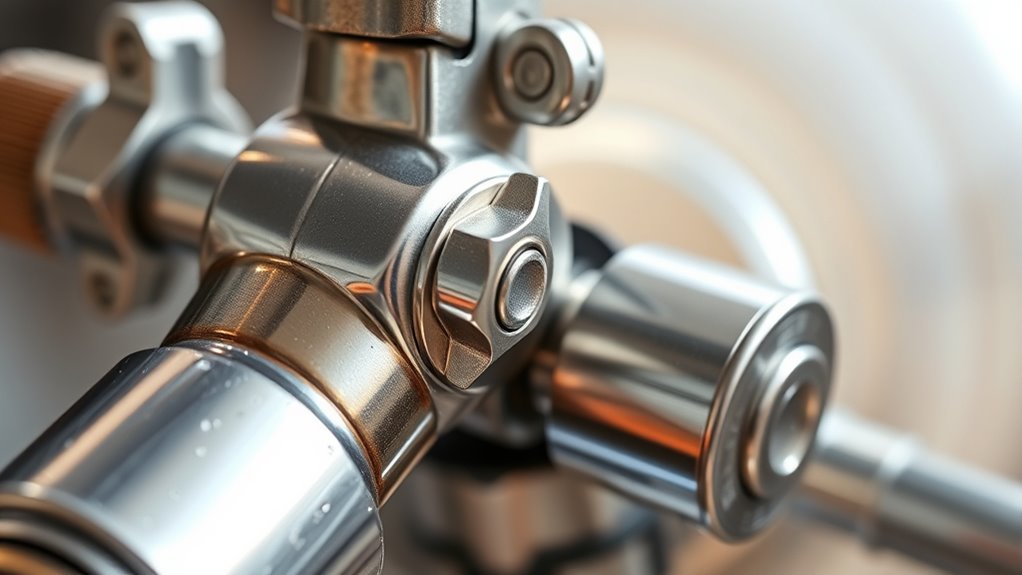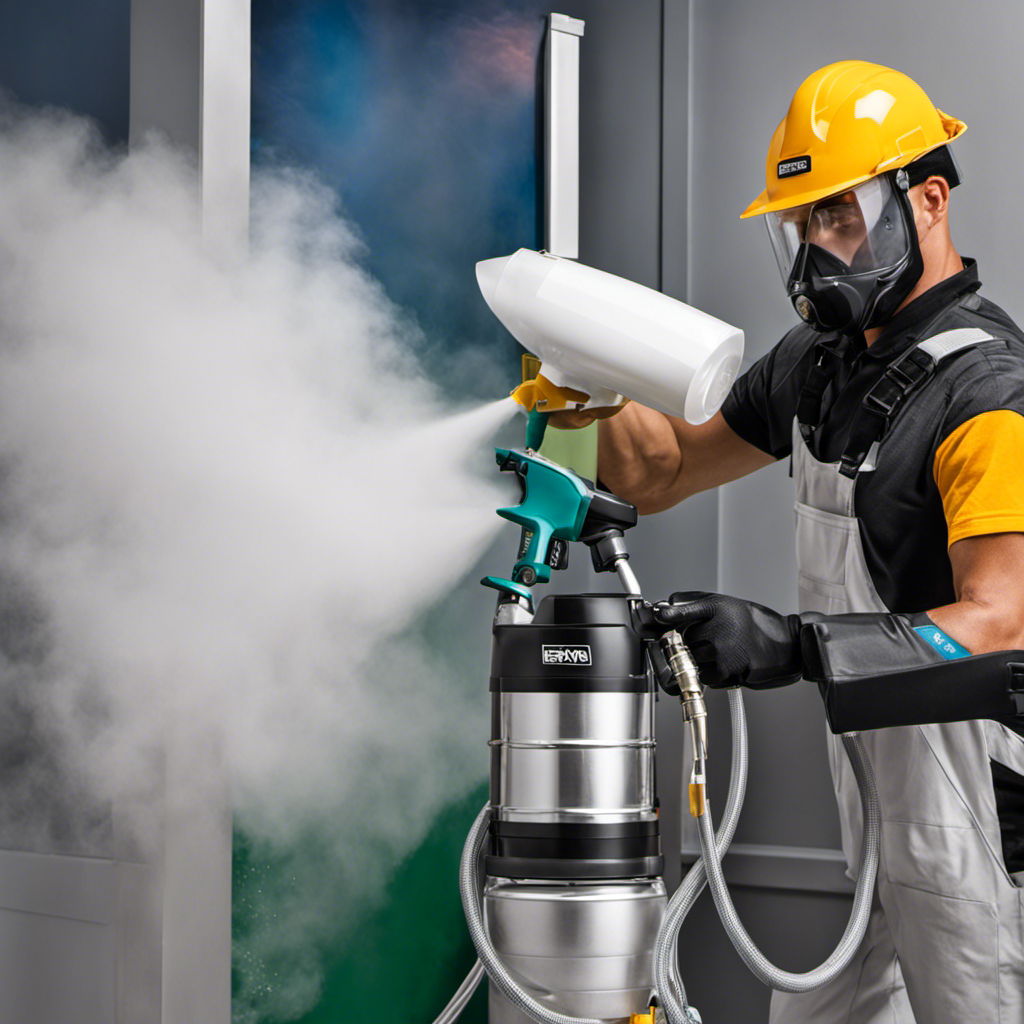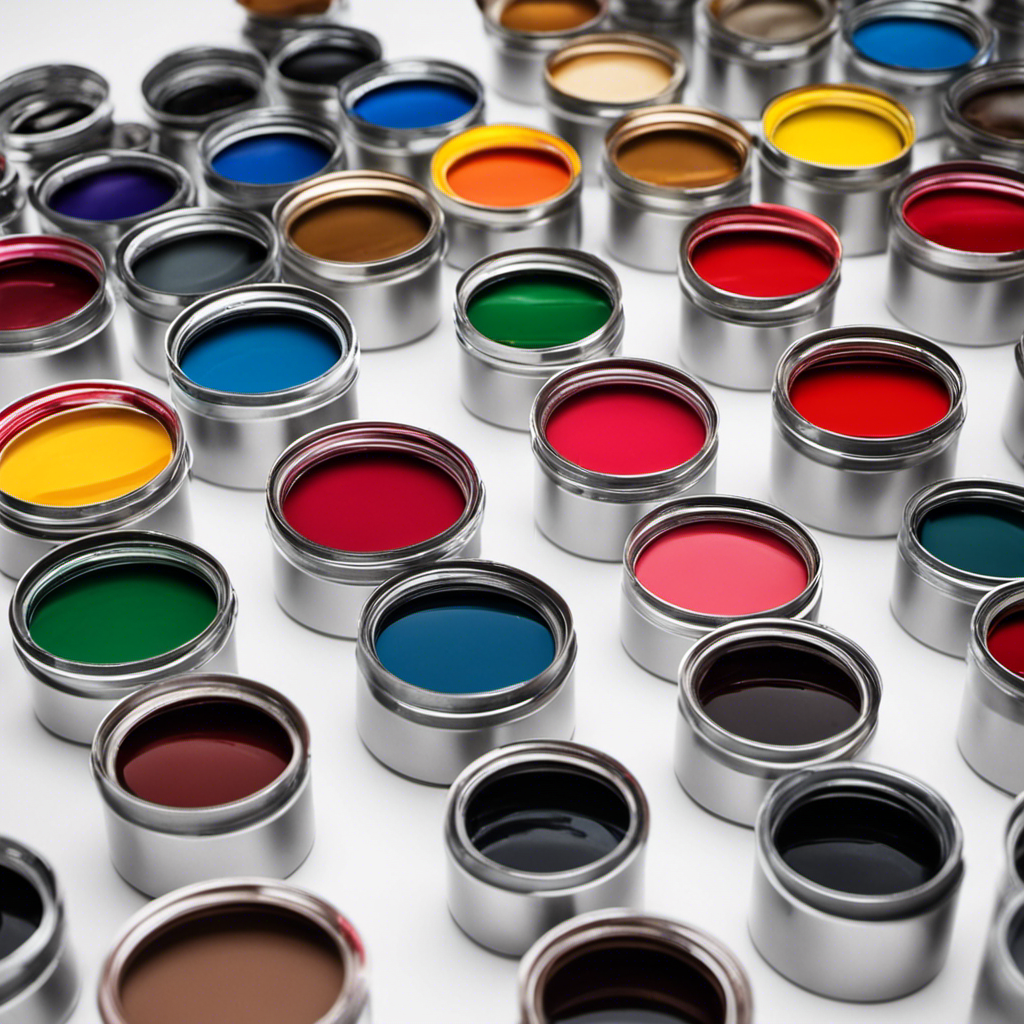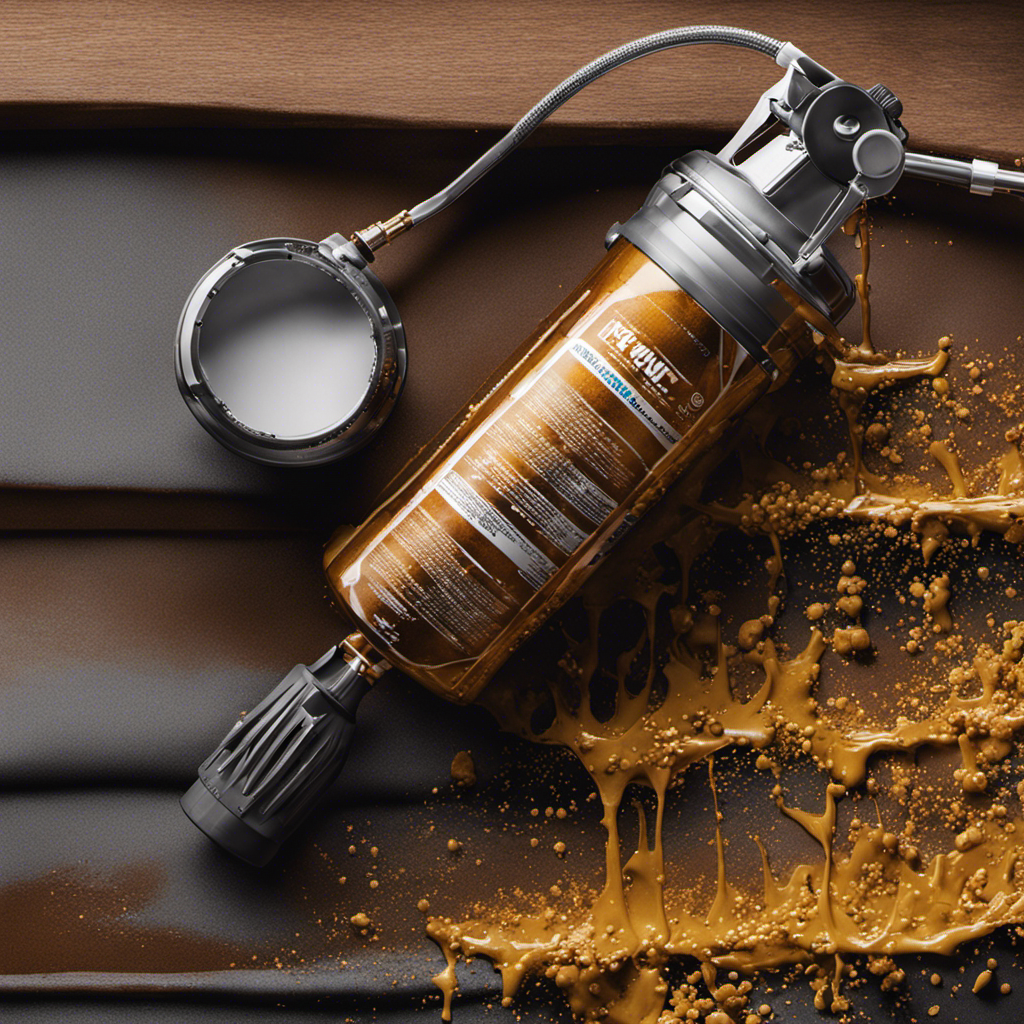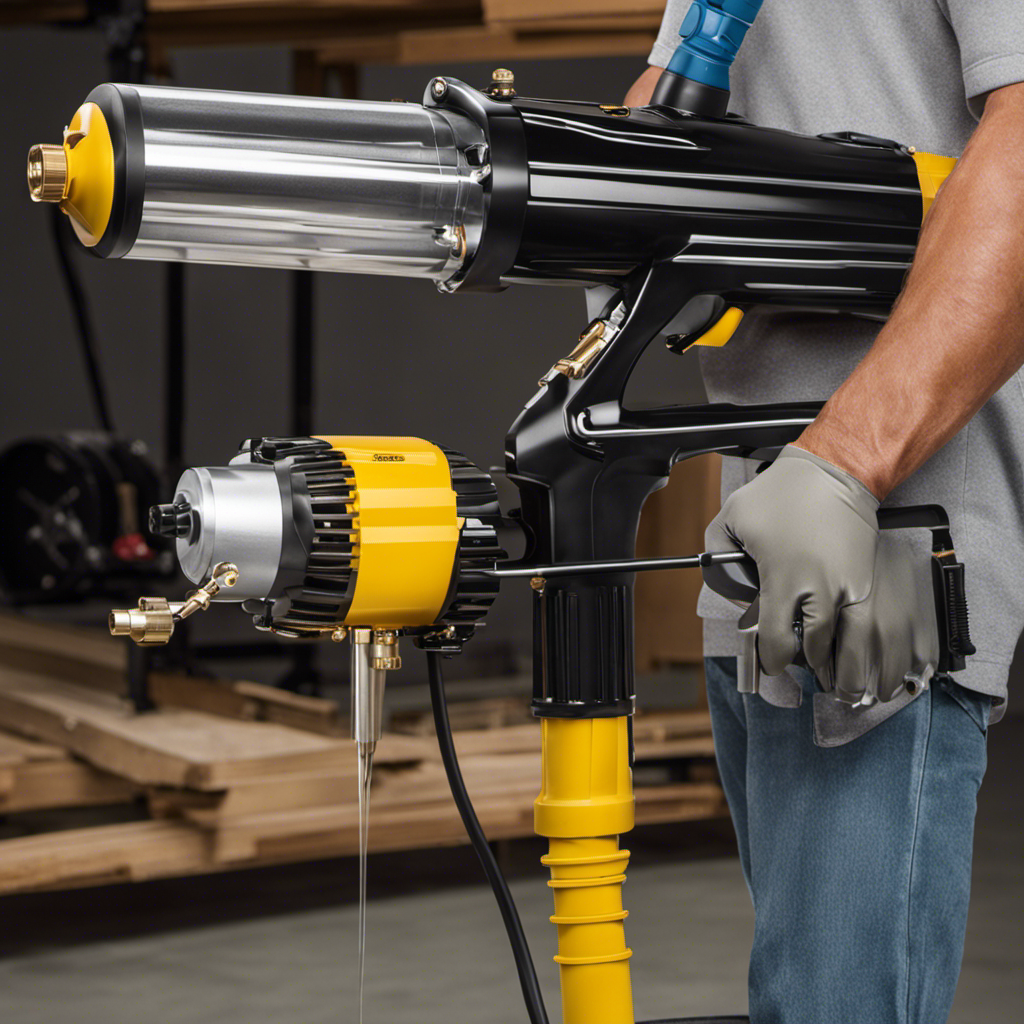To prevent rust in your paint sprayer, make sure to clean and dry all metal parts thoroughly after each use, especially in hard-to-reach areas. Apply protective coatings or rust-resistant paint and use lubricants on moving components. Store your sprayer in a dry, well-ventilated space and keep it off damp floors. Regular inspections and maintenance help catch early signs of corrosion. Keep your equipment protected, and you’ll learn more about keeping it rust-free.
Key Takeaways
- Regularly clean and dry metal parts after each use to remove paint residue and prevent moisture buildup.
- Apply protective coatings or rust-resistant paint to create a moisture barrier on metal surfaces.
- Store the sprayer in a dry, well-ventilated area away from damp surfaces and humidity.
- Use lubricants and corrosion inhibitors periodically to reduce friction and prevent rust formation.
- Inspect for rust spots or damage regularly, and address issues promptly to maintain metal integrity.
Regularly Clean and Dry Metal Components
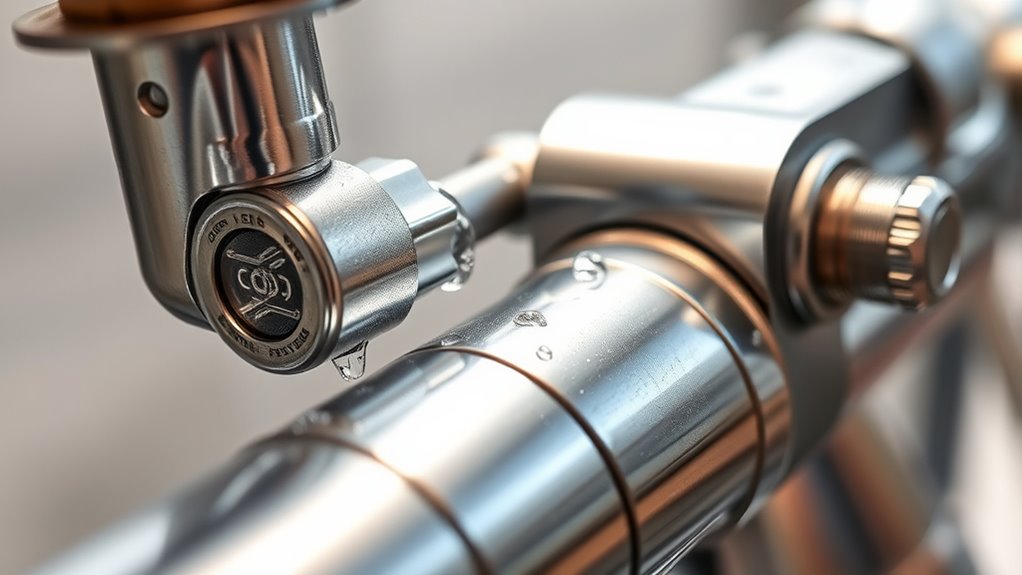
To prevent rust from forming on your paint sprayer, it’s essential to regularly clean and dry its metal components. The metal surface is prone to moisture buildup, which can lead to corrosion if left untreated. After each use, wipe down all metal parts with a clean cloth to remove paint residue and dirt. Use effective drying techniques, such as air drying or wiping with a dry, lint-free cloth, to guarantee no moisture remains. Pay special attention to crevices and joints where water can hide. Proper drying prevents water from lingering and minimizes rust risk. Additionally, utilizing protective coatings can offer an extra layer of defense against corrosion. Applying a rust-inhibiting metal protectant after cleaning can further extend the lifespan of your sprayer’s metal parts. Regularly inspecting and maintaining your equipment promotes long-term durability and prevents unexpected malfunctions. Ensuring proper maintenance practices can significantly reduce the chances of rust formation. Incorporating preventative measures, such as storing your sprayer in a dry environment, can greatly reduce exposure to moisture. Consistent cleaning and thorough drying keep your sprayer’s metal surfaces in top condition, extending its lifespan and ensuring ideal performance during your projects.
Apply Protective Coatings and Lubricants
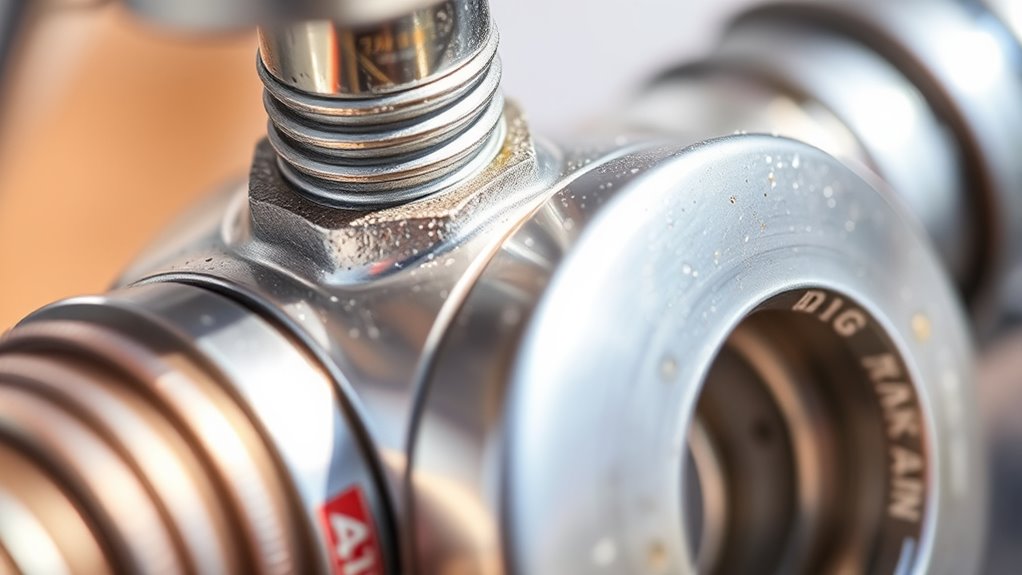
Applying protective coatings and lubricants to your paint sprayer is an essential step in preventing rust and ensuring smooth operation. Using corrosion inhibitors or metal primers creates a barrier against moisture that causes rust. Metal primers help prepare the surface for additional coatings, providing extra protection. Lubricants reduce friction on moving parts, preventing wear and corrosion over time. Make sure to apply a thin, even layer of rust-resistant paint or protective coating after cleaning. Additionally, maintaining awareness of spiritual energy can promote overall well-being and harmony during your maintenance routine. Recognizing the importance of preventive maintenance can further extend the lifespan of your equipment and improve performance. Incorporating proper storage practices also helps protect metal components from exposure to moisture and environmental elements, which is crucial for metal preservation and longevity.
Store Your Paint Sprayer Properly
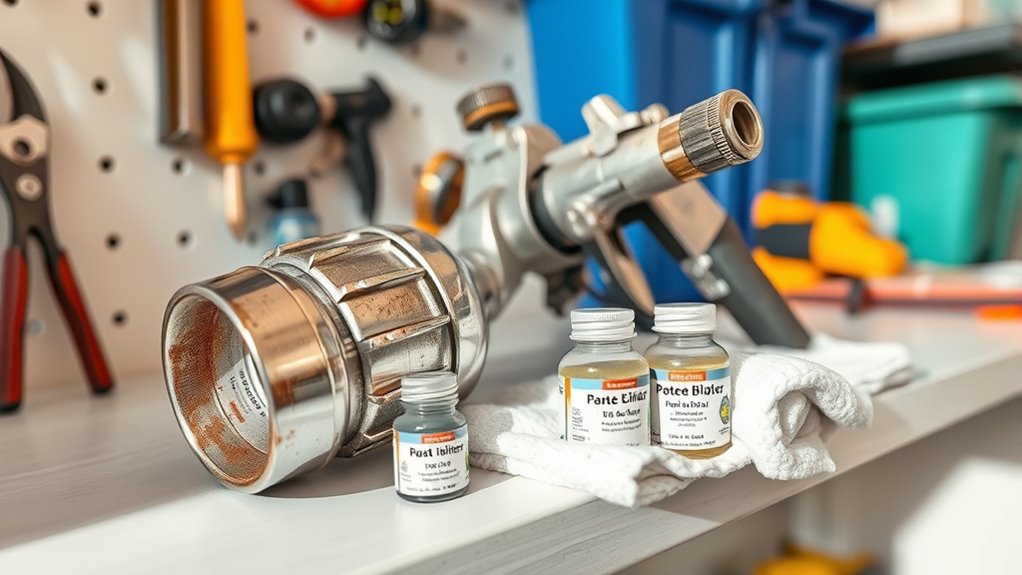
Store Your Paint Sprayer Properly. When you’re finished using your paint sprayer, make sure to store it in a dry area to prevent rust. Cover it with a protective cover to keep dust and moisture away. Proper storage helps keep your sprayer in top condition for future projects. Additionally, consider maintenance and care routines to extend the lifespan of metal parts. Implementing regular cleaning can further reduce the risk of corrosion and keep your equipment functioning smoothly. Using appropriate storage methods ensures that sensitive metal components are protected from environmental damage.
Store in a Dry Area
Storing your paint sprayer in a dry area is essential for preventing rust and ensuring it stays in good working condition. A dry environment minimizes exposure to moisture that can cause metal parts to corrode. Choose a storage space that is well-ventilated and free from humidity, such as a climate-controlled garage or shed. Proper metal storage involves keeping the sprayer off the floor and away from damp surfaces. If possible, hang the sprayer or place it on a shelf where it won’t collect water or dust. Avoid storing it in basements or outdoor locations prone to moisture. Ensuring your paint sprayer is kept in a dry environment helps preserve its metal parts, reducing the risk of rust and extending its lifespan. Regularly inspecting air quality indicators can help you identify when conditions are no longer ideal for storage. Additionally, proper storage practices can further protect your equipment from environmental damage, as well-maintained storage conditions contribute to preventing corrosion and maintaining optimal performance. Using desiccants or moisture absorbers in your storage area can also help control humidity levels and prevent rust formation.
Use Protective Covers
Using protective covers is a simple yet effective way to keep your paint sprayer free from rust and damage. Protective covers act as moisture barriers, shielding your equipment from humidity and dust that can cause corrosion. When storing your sprayer, ensure it’s fully dry and then cover it with a breathable material or a dedicated protective cover. This prevents moisture buildup on metal parts, especially in damp environments. Proper use of protective covers not only prolongs your sprayer’s life but also helps maintain excellent performance by keeping metal parts dry and rust-free. Additionally, choosing covers made from weather-resistant materials can provide extra protection against environmental elements. Regularly inspecting and cleaning your covers will further ensure they remain effective at preventing moisture exposure, which is essential for metal part preservation. Incorporating sound storage practices in your storage routines can further optimize your equipment’s longevity and reliability. Being aware of pinball machine weights can help you plan proper storage space and prevent accidental damage during setup or relocation.
Use Rust-Resistant Materials and Parts
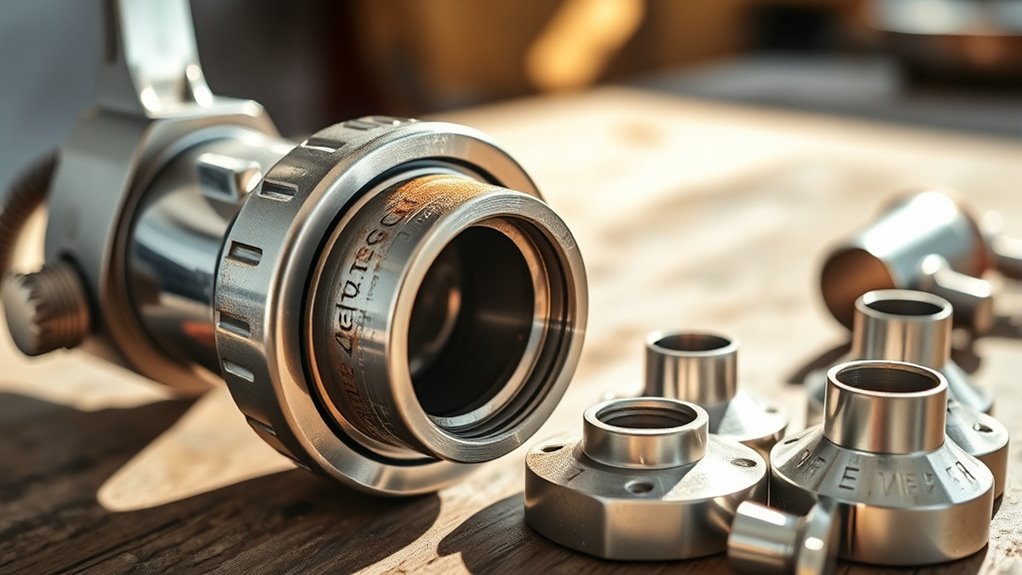
Choosing rust-resistant materials and parts for your paint sprayer is one of the most effective ways to prevent corrosion. Focus on selecting metal alloys that resist rust, such as stainless steel or aluminum, which naturally withstand moisture better. Incorporate corrosion inhibitors into your equipment’s components or coatings to add an extra layer of protection. When choosing parts, look for those specifically designed with rust-resistant properties, ensuring they won’t easily degrade over time. Proper metal alloy selection minimizes the risk of rust formation, reducing maintenance needs and extending your sprayer’s lifespan. Additionally, being aware of the environmental impacts of wood-burning can inform your decisions to choose more sustainable practices and materials. Selecting appropriate storage conditions also plays a crucial role in preventing rust, as keeping equipment dry and properly stored reduces moisture exposure. By prioritizing durable, corrosion-resistant materials, you can substantially cut down on rust-related issues and keep your equipment operating smoothly for longer periods.
Inspect and Maintain Your Equipment Frequently
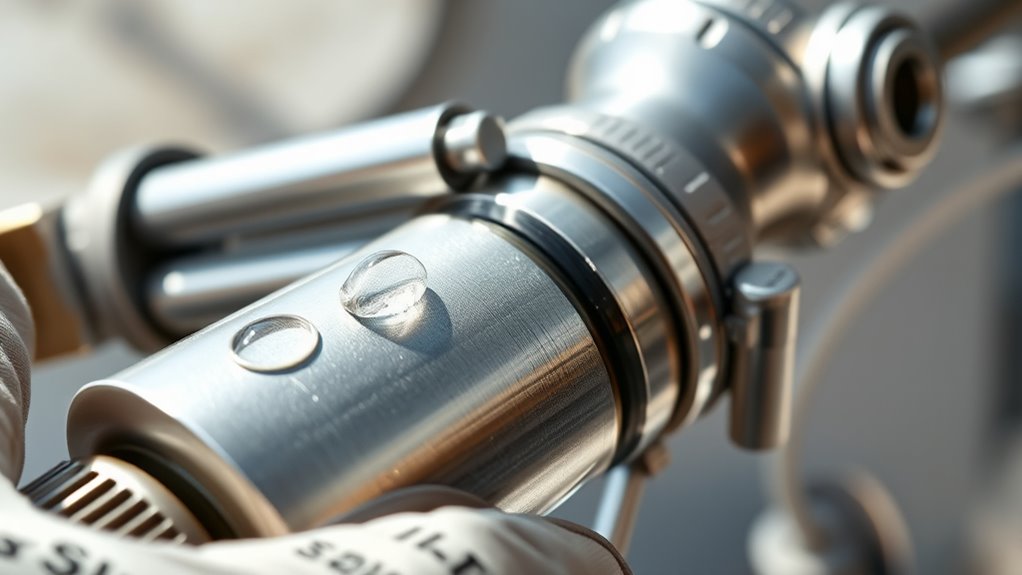
Regularly inspecting your paint sprayer helps catch rust early before it spreads. Sticking to a proper maintenance schedule keeps parts clean and functioning properly. By staying proactive, you can prevent costly repairs and extend your equipment’s lifespan. Utilizing industry best practices for cleaning and storage further safeguards metal components against corrosion. Incorporating preventive maintenance techniques will help identify potential issues before they become significant problems. Additionally, understanding how AI developments in healthcare and technology are influencing maintenance tools can lead to more innovative approaches. For instance, some modern systems use advanced diagnostic tools that can detect early signs of wear and rust.
Regular Inspection Routines
To prevent rust from taking hold in your paint sprayer, you need to inspect and maintain your equipment often. Use an inspection checklist to identify early signs of corrosion or damage. Check metal parts for rust spots, chipped paint, or moisture buildup. Ensure all moving parts are functioning smoothly and that seals are intact. Regularly clean and dry components after each use, applying rust prevention techniques like light oil coatings on metal surfaces. Pay close attention to hard-to-reach areas where moisture can hide. Consistent inspections help catch issues before they worsen, saving you from costly repairs later. By staying vigilant and following a thorough inspection routine, you minimize the risk of rust and extend your equipment’s lifespan.
Proper Maintenance Schedule
Establishing a proper maintenance schedule is essential to keep your paint sprayer in ideal condition. Regular inspections help you spot early signs of rust or corrosion, allowing timely metal treatment. Use corrosion inhibitors during cleaning to protect metal parts from moisture. Schedule routine checks every few uses, focusing on nozzles, filters, and metal surfaces. Incorporate cleaning, lubrication, and applying rust preventatives into your plan.
| Task | Frequency | Purpose |
|---|---|---|
| Metal surface cleaning | After each use | Remove residue, prevent rust |
| Inspect for corrosion | Weekly or after heavy use | Detect early metal damage |
| Apply corrosion inhibitors | Monthly | Protect metal parts from rust |
| Lubricate moving parts | Every 2-3 uses | Ensure smooth operation |
| Deep maintenance | Quarterly | Long-term equipment health |
Avoid Exposure to Moisture and Humid Environments
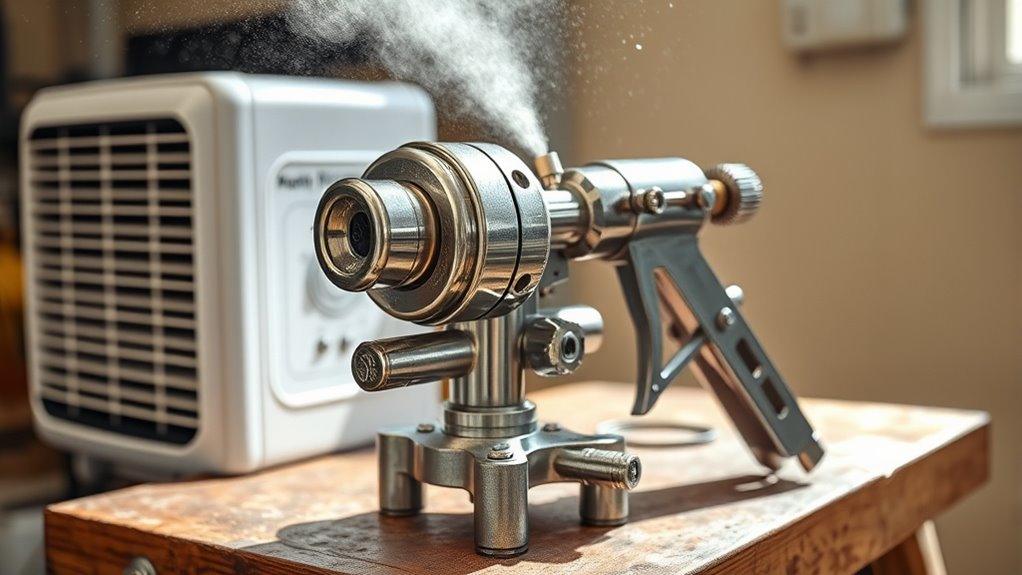
Moisture and humidity are major factors that accelerate rust formation on your paint sprayer. To prevent this, you need to minimize exposure to damp environments. Keep your equipment in a dry, well-ventilated space, and avoid storing it in basements or outdoor sheds where humidity levels fluctuate. Implement humidity control measures, such as using a dehumidifier, to maintain low moisture levels inside your storage area. Regularly check the environment for excess dampness and adjust your dehumidifier use accordingly. Ensuring your paint sprayer stays dry prevents rust from developing on metal parts, extending its lifespan. Remember, controlling humidity isn’t just about storage, but also about maintaining a consistently dry environment that shields your equipment from moisture-related damage.
Perform Routine Maintenance and Preventative Checks
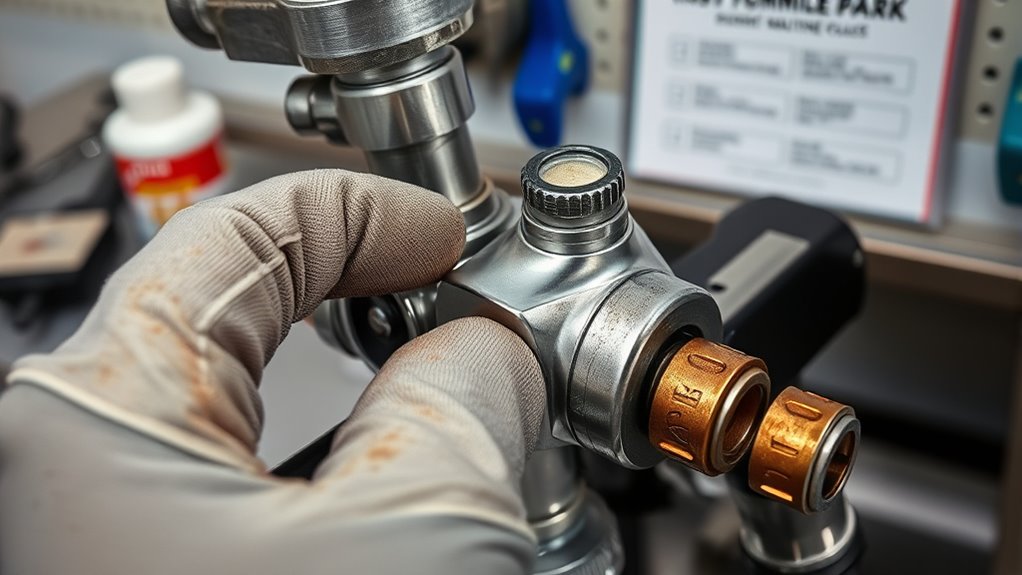
Regular maintenance and preventative checks are key to keeping rust at bay on your paint sprayer. Start by inspecting metal surfaces regularly for signs of wear or corrosion. Use proper metal surface treatment techniques, like cleaning and applying corrosion inhibitors, to protect vulnerable parts. Lubricate moving components to prevent moisture buildup, which can lead to rust. Check seals and fittings for leaks or damage, and replace worn parts promptly. Keep the sprayer clean and dry after each use, especially if you’ve used water-based paints. Periodically apply protective coatings or rust inhibitors to metal surfaces to create a barrier against moisture. Consistent upkeep helps prevent rust formation and extends your sprayer’s lifespan, ensuring it operates smoothly and efficiently every time you use it.
Frequently Asked Questions
How Often Should I Replace Worn Metal Parts to Prevent Rust?
You should replace worn metal parts regularly to maintain effective metal maintenance and prevent rust. Follow a consistent replacement schedule based on usage and visual inspections, typically every few months or after heavy use. Keep an eye out for signs of corrosion or damage, and don’t wait too long to swap out compromised parts. This proactive approach guarantees your equipment stays rust-free and functions smoothly, saving you time and costly repairs later.
Can Using Water-Based Paints Increase the Risk of Rust Formation?
Using water-based paints can increase the rust risk for your paint sprayer’s metal parts, especially if you don’t clean the equipment thoroughly afterward. Water residue can promote rust formation over time. To minimize this risk, make sure you rinse all metal parts well with water after each use, dry them completely, and consider applying a protective coating. Proper maintenance helps prevent rust and keeps your sprayer in top condition.
Are There Eco-Friendly Options for Rust-Resistant Coatings?
Imagine safeguarding your tools with nature’s own armor. Eco-friendly options like biodegradable coatings and plant-based rust inhibitors are ideal choices. These alternatives actively combat rust without harming the environment. You can confidently choose these sustainable solutions, knowing they provide effective protection while keeping your workspace green. Embrace eco-consciousness and extend your paint sprayer’s lifespan with these environmentally safe, rust-resistant coatings that work as hard as you do.
How Does Temperature Fluctuation Affect Metal Rusting in Paint Sprayers?
Temperature fluctuations cause metal parts to expand and contract, creating tiny cracks that allow moisture intrusion. These micro-cracks expose metal to moisture, accelerating rust formation inside your paint sprayer. When temperatures swing between hot and cold, you increase the risk of rusting because the metal can’t stay stable. To protect your equipment, store your sprayer in a consistent environment, and regularly check for signs of moisture or corrosion.
What Are the Signs Indicating My Sprayer Needs Professional Rust Treatment?
If you notice rust spots or signs of metal corrosion on your paint sprayer, it’s time to seek professional rust treatment. These signs indicate that rust has penetrated deeply, risking damage to your equipment. Ignoring these issues can lead to inefficient spray patterns or failure. A professional treatment restores functionality, prevents further corrosion, and extends your sprayer’s lifespan, ensuring you get the best results on every project.
Conclusion
By following these steps, you’ll keep your paint sprayer in top shape and free from rust. But don’t get complacent—skipping even one maintenance task could lead to unexpected failures when you need it most. Stay vigilant, inspect regularly, and never underestimate the power of proper care. Your sprayer’s longevity depends on your attention today. Are you prepared to take that extra step and guarantee it’s always ready for your next project?
A seasoned painter with over 15 years in the industry, Mike transitioned from hands-on painting projects to the digital world of paint sprayers. His extensive experience gives him a unique perspective on what users truly need when it comes to painting tools. As the Editor in Chief of Paint Sprayer Zone, Mike ensures that every piece of content not only provides value but also reflects the realities of painting — the challenges, the joys, and the intricate details.
